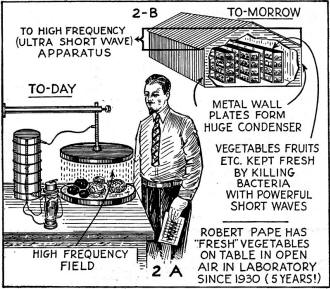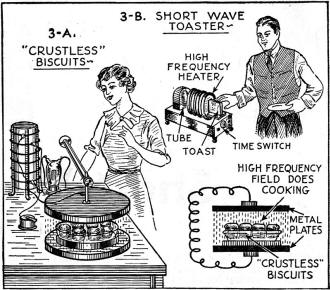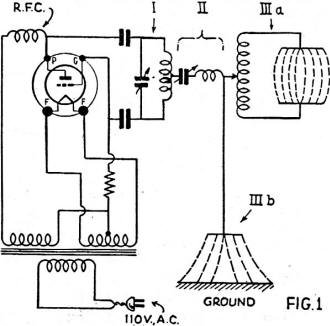|
April 1935 Short Wave Craft
 [Table
of Contents] [Table
of Contents]
Wax nostalgic about and learn from the history of early electronics. See articles
from Short Wave Craft,
published 1930 - 1936. All copyrights hereby acknowledged.
|
As with many relatively new technologies, the exuberance over radio peaked quickly
once the benefits of communications over long distances without the need for wires
was realized by the public. After a couple decades a lot of "authorities" began
pontificating about how all the useful applications of radio waves had been discovered
and that any new innovation would be merely incremental improvements in existing
technology. Novel circuits for minimizing static over the radio or maybe building
more powerful transmitters for longer range were the only concepts within reach
of their limited imaginations. Similar phenomena occurred for those who thought
airplanes would always have two (or more) wings and that automobiles would never
be faster than a train. This 1935 issue of Short Wave Craft magazine reported
on the beginnings of investigations into the use of radio waves for heating and
treating food and other substances in a manner that did not create a "crust" on
the outside from a necessarily conductive process. Radio waves agitate matter at
the molecular level throughout the entire mass, so heat is generated directly, with
the added benefit of conduction aiding the heating (cooking) process. Ten years
after this article appeared, Raytheon began selling its commercial
Radarange microwave oven, and then in 1972 Litton introduced
microwave
ovens for domestic sale. My mother got her first microwave oven for
Christmas of 1979, which by that time my older sister, Gayle, was living in a
dormitory at the University of Maryland, and I was in the U.S. Air Force. That
left her, my father, and three younger sisters (Bonnie & Brenda [twins], and
Tina) in the house. She sure could have used the oven a few years earlier when
there were seven hungry souls to feed.
New Stunts With Short Waves
By Dr. P. Hatschek, Berlin
Among the newest accomplishments of short waves we have "crustless" cooking -
the production of artificial fever for the treatment of various human ailments -
the preservation of "fresh" vegetables and fruit-making toast by short waves, et
cetera.

A European expert has in his laboratory specimens of "fresh"
vegetables such as cauliflower, tomatoes, and lettuce, which he has kept on a table
in "open air," since 1930, by the aid of shortwave treatments. Tomorrow undoubtedly
we shall have short waves applied to large "preserving centers" in which many tons
of vegetables and fruits will be treated daily to preserve them.

Tomorrow we shall be cooking our biscuits and making our toast
by short waves as the picture shows. Biscuits for instance, when cooked in a short
wave field are "crust-less."

Circuit for producing short wave field for treatment of vegetables,
etc.
For several years now we have heard unfounded prophecies that the evolution of
the radio industry had about reached a definite development, or at least so near
to the point of near-perfection that we would have to become resigned to a substantially
diminished market, particularly in the case of radio receiving sets. Recent developments
actually point in the opposite direction. The late German radio shows have shown
such notable improvements and have brought so many new ideas into the radio industry,
that there has been a tendency to exchange old sets for newer and more up-to-date
equipment. This is particularly true now with the development of inexpensive single-circuit
receivers with fixed selection and dynamic speakers, superheterodynes with only
three tubes, marked acoustical improvements and last - but by no means least - the
new short-wave receivers. Although a wide variety of possibilities have opened before
the industry, it is perhaps not premature to ask whether the industry will not definitely
concentrate upon the exploitation of only a few of these new developments. We are,
at present, merely indicating the possibilities of these new fields, so that as
soon as the apparatus has emerged from the laboratory stage, manufacturers will
be able to place it in production forthwith.
"Crust-less" Baking Tomorrow by Short Waves
One of the most interesting and promising new fields before the radio industry
is that of short-wave generation for special purposes, particularly at the present
time in the ultra-short-wave range of 3 to 15 meters. If waves of this range pass
through a circuit containing a condenser of appreciable capacity and with a considerable
distance between the plates, a variety of remarkable phenomena occur with regard
to objects (condenser dielectrics) introduced between the plates. Professor Esau
has conducted an interesting experiment in which he placed a paraffin-water emulsion
between the plates. The effect of the short waves boiled the water out of the emulsion
although its temperature was only 50° to 80° Centigrade; in other words, 20° to
50° below the boiling point of water.
Therapeutic (medical) applications of this phenomenon are conceivable; for instance,
replacing the emulsion by some infected portion of a human organism. Certain pathogenic
constituents of the blood could thus be eliminated, while the body temperature would
experience no dangerous increase. This is the principle upon which the modern "fever-machines"
are based. It is already possible to apply this short-wave apparatus properly specific
as to their bactericidal effect by regulating the wavelengths.
Bacteria are also responsible for the spoiling of "fresh" foods; since modern
hygienic science disapproves of the sterilization of foods by boiling, etc., because
of the destruction of important vitamins, it seems that the way is being opened
to the utilization of short waves in this case also. The almost indefinite preservation
of foods without the elimination of their vitamin content could thus be effected
by simply exposing the foods to the correct type (frequency) of short-wave radiation.
Somewhere in Holland a Robert Pape is working on this problem at present. In one
of his laboratories there are a number of "fresh" vegetables, such as cauliflower,
tomatoes and lettuce, on a table in open air, which have remained there since 1930
without losing any of their freshness; they have constantly been exposed to short-wave
radiation.
As can readily be seen, the step from a laboratory apparatus to a "household
implement" is not such a great one to take. Moreover, such an apparatus would be
superior to our present refrigerators and certainly could hardly be more expensive
to operate. Furthermore, there is the possibility of treating truly immense quantities
of foods, quantities impossible to treat by present methods. Gigantic warehouses
or water reservoirs could easily be kept in condition by using opposite walls as
condenser plates. As yet these special generators are manufactured only for therapeutic
purposes, especially those made by F. Reiner & Co., in Vienna and Dr. Paul Groag
and Victor Tomberg, illustrated in Fig. 1. As is apparent from the diagram given,
the idea of the hook-up lies in the three oscillating circuits, of which the middle
one, No.2, is not so much a circuit as it is a "bridge." The first circuit is the
usual regenerating-oscillating circuit, and the happy idea of the variable bridge
(2) will make it possible to have the therapeutic circuit at practically any distance
from the primary. In the therapeutic circuit (3) either two condenser plates can
be used as in 3A or one plate, with the ground functioning at the second as in 3B.
The body, or portion of the body to be treated, would then be placed between the
two plates or between the plate and the ground respectively. The latter arrangement
changes the structure of the field, as indicated in the diagram, and it would be
more efficient for treating superficial areas of infection, whereas arrangement
3A would seem to be indicated for the irradiation of the subsurface. It is to be
expected that in the near future small therapeutic sets of this kind will replace
the present rather cumbersome arrangements and displace our high-frequency apparatus
of today.
"Crustless" Baking Tomorrow by S-W's
Besides this field of utility in hygiene, there is also the possibility of using
this principle in the arts of cooking and baking. Very even and penetrating heat
will be achieved. As yet baking by any other means necessarily produces a crust;
that is, the surface of the baked object is chemically different from the inside!
With ultra short waves, on the other hand, it would be possible to achieve "crustless"
baking! According to reports in the daily newspapers, a toaster for household use
based on this principle has already been invented. It is by no means impossible
that suitable arrangements of tubes and hook-ups will improve the efficiency of
such cooking and baking utensils to the point where they will be far superior to
our present electrical apparatus, based on the principle of ohmic resistance.
As can be seen from the foregoing, even the few possibilities in short-wave radio
described in this article are not so far in the future as might be generally supposed.
Indeed the laboratory work in some fields has progressed so far, that many types
of apparatus have been manufactured as experimental specimens, and we may, in the
not-far-distant future, expect the commercial appearance of a number of such devices.
These speculations as to the enlargement of present radio technique and the opening
up of new markets for the industry seem, therefore, not altogether out of place.
Posted March 23, 2020
|































